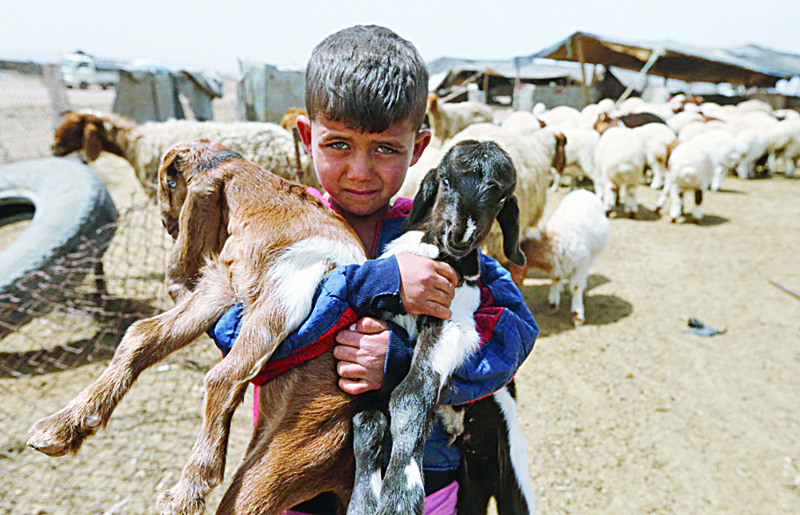 A bedouin boy holds the lambs of Abu Mari, a livestock farmer who raises camels, goats, and sheep, in the village of Ghezlaniah, in the countryside of the Badia region southeast of the capital Damascus. - AFP
A bedouin boy holds the lambs of Abu Mari, a livestock farmer who raises camels, goats, and sheep, in the village of Ghezlaniah, in the countryside of the Badia region southeast of the capital Damascus. - AFP
AL-HAYJANA, Syria: Syrian farmer Mohammad Saasaani grew up grazing sheep in the vast Badia rangelands, but today they are rife with jihadists, a place too dangerous to take the herd. Like many livestock herders, Saasaani can barely afford fodder for his dwindling flock. "We're worried we'd be marching off to die with our sheep," said the 51-year-old, a prominent sheep breeder in the Damascus countryside. "We fear landmines, Islamic State group fighters and bandits," he added, a red and white scarf wrapped around his shoulders.
The Badia, a desert and steppe region which runs from the countryside around the capital to the border with Iraq, was where herders roamed with their animals. But Syria's decade-long conflict has turned it into a no-go zone, denying livestock farmers their main source of grazing.
The Badia used to supply 70 percent of feed for animals across the country before the war, says Osama Hammoud, who runs the livestock department at the agriculture ministry. Now it is a hideout for IS jihadists who use it as a launching pad for their attacks, even after the collapse of their "caliphate" in 2019. Russian and Syrian warplanes have routinely targeted IS positions in the area, but failed to stamp them out. The Badia is also littered with landmines and other explosive remnants, which have killed and maimed hundreds across Syria in recent years.
'Looking for safety'
In the rural area of Al-Hayjana outside Damascus, Saasaani tended to a newborn lamb, while also keeping an eye on the rest of his flock under the scorching spring sun. Herding runs in his family. Saasaani's father used to take him along to the Badia, hundreds of sheep in tow. They would often reach the gates of the ancient city of Palmyra in central Syria, over 200 kilometres (130 miles) northeast of Damascus, but the war "has limited the areas we can access," he said.
With reduced grazing ground, Saasaani must turn to imported fodder, which is increasingly expensive due to the devaluation of the Syrian pound. Skyrocketing feed prices have forced him to sell most of his flock, depleting it from 500 to less than 100. The UN's Food and Agricultural Organization (FAO) says Syria has lost up to 45 percent of its livestock since the start of the war. Hammoud, from the agriculture ministry, said Syria once boasted 15 million sheep and 10 million cows in 2010.
That number has been slashed nearly in half. Near his sheep and goat pen on the edge of the desert, Hasan Touhan sat beneath a large tent he once used to pitch in the Badia. "I used to take my sheep all the way to the border with Iraq, but with the start of the war we stopped moving around," the 50-year-old said. "Now we are looking for safety, rather than food for the livestock."
Slaughter or sell
Abdul Razzaq Wayha, the director of an animal welfare center in rural Damascus, said the loss of grazing in the Badia was just one of many problems. Livestock numbers are dwindling as droughts worsen year after year, he said. FAO's Syria representative Mike Robson said mass displacement over the years of war had also forced fleeing farmers to abandon animals they could not feed.
"The livestock sector in Syria has been really quite badly affected by the crisis," he said. Overall, "the lack of availability of feed" has been a key factor. FAO is trying to assist by providing fodder and improving local feed production to meet the demand. But unable to afford food for all their animals, farmers are still being forced to slaughter or sell some of them. They include cattle farmer Saleh Farah, who has been forced to put his favorite cow Saada on the market, so he can afford to buy feed for the rest. "Fodder alone makes up 75 percent of the cost of raising cows," the 59-year-old said. "This makes meat very expensive." - AFP




